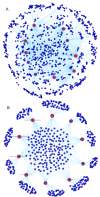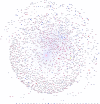Molecular mechanisms of pathogenesis in hepatocellular carcinoma revealed by RNA‑sequencing
- PMID: 28901494
- PMCID: PMC5865798
- DOI: 10.3892/mmr.2017.7457
Molecular mechanisms of pathogenesis in hepatocellular carcinoma revealed by RNA‑sequencing
Abstract
The present study aimed to explore the underlying molecular mechanisms of hepatocellular carcinoma (HCC). RNA‑sequencing profiles GSM629264 and GSM629265, from the GSE25599 data set, were downloaded from the Gene Expression Omnibus database and processed by quality evaluation. GSM629264 and GSM629265 were from HCC and adjacent non‑cancerous tissues, respectively. TopHat software was used for alignment analysis, followed by the detection of novel splicing sites. In addition, the Cufflinks software package was used to analyze gene expressions, and the Cuffdiff program was used to screen for differently expressed genes (DEGs) and differentially expressed splicing variants. Gene ontology functional enrichment and Kyoto Encyclopedia of Genes and Genomes pathway enrichment analyses of DEGs were also performed. Transcription factors (TFs) and microRNAs (miRNAs) that regulate DEGs were identified, and a protein‑protein interaction (PPI) network was constructed. The hub node in the PPI network was obtained, and the TFs and miRNAs that regulated the hub node were further predicted. The quality of the sequencing data met the standards for analysis, and the clean reads were ~65%. Most sequencing reads mapped into coding sequence exons (CDS_exons), whereas other reads mapped into exon 3' untranslated regions (UTR_Exons), 5'UTR_Exons and Introns. Upregulated and downregulated DEGs between HCC and adjacent non‑cancerous tissues were screened. Genes of differentially expressed splicing variants were identified, including vesicle‑associated membrane protein 4, phosphatidylinositol glycan anchor biosynthesis class C, protein disulfide isomerase family A member 4 and growth arrest specific 5. Screened DEGs were enriched in the complement pathway. In the PPI network, ubiquitin C (UBC) was the hub node. UBC was predicted to be regulated by several TFs, including specificity protein 1 (SP1), FBJ murine osteosarcoma viral oncogene homolog (FOS), proto‑oncogene c‑JUN (JUN), FOS‑like antigen 2 (FOSL2) and SWI/SNF‑related, matrix‑associated, actin‑dependent regulator of chromatin, subfamily A, member 4 (SMARCA4), and several miRNAs, including miR‑30 and miR‑181. Results from the present study demonstrated that UBC, SP1, FOS, JUN, FOSL2, SMARCA4, miR‑30 and miR‑181 may participate in the development of HCC.
Figures



Similar articles
-
Identification of invasion-metastasis-associated microRNAs in hepatocellular carcinoma based on bioinformatic analysis and experimental validation.J Transl Med. 2018 Sep 29;16(1):266. doi: 10.1186/s12967-018-1639-8. J Transl Med. 2018. PMID: 30268144 Free PMC article.
-
Identifying hepatocellular carcinoma-related hub genes by bioinformatics analysis and CYP2C8 is a potential prognostic biomarker.Gene. 2019 May 25;698:9-18. doi: 10.1016/j.gene.2019.02.062. Epub 2019 Feb 27. Gene. 2019. PMID: 30825595
-
Identification and interaction analysis of key genes and microRNAs in hepatocellular carcinoma by bioinformatics analysis.World J Surg Oncol. 2017 Mar 16;15(1):63. doi: 10.1186/s12957-017-1127-2. World J Surg Oncol. 2017. PMID: 28302149 Free PMC article.
-
Integrated miRNA-mRNA network revealing the key molecular characteristics of ossification of the posterior longitudinal ligament.Medicine (Baltimore). 2020 May 22;99(21):e20268. doi: 10.1097/MD.0000000000020268. Medicine (Baltimore). 2020. PMID: 32481304 Free PMC article.
-
[Gene regulatory network of hepatocellular carcinoma: a review].Sheng Wu Gong Cheng Xue Bao. 2016 Oct 25;32(10):1322-1331. doi: 10.13345/j.cjb.160045. Sheng Wu Gong Cheng Xue Bao. 2016. PMID: 29027443 Review. Chinese.
Cited by
-
m6A methyltransferase METTL14‑mediated RP1‑228H13.5 promotes the occurrence of liver cancer by targeting hsa‑miR‑205/ZIK1.Oncol Rep. 2024 Apr;51(4):59. doi: 10.3892/or.2024.8718. Epub 2024 Mar 1. Oncol Rep. 2024. PMID: 38426536 Free PMC article.
-
Specific MiRNAs in naïve T cells associated with Hepatitis C Virus-induced Hepatocellular Carcinoma.J Cancer. 2021 Jan 1;12(1):1-9. doi: 10.7150/jca.49594. eCollection 2021. J Cancer. 2021. PMID: 33391397 Free PMC article.
-
MKL1 regulates hepatocellular carcinoma cell proliferation, migration and apoptosis via the COMPASS complex and NF-κB signaling.BMC Cancer. 2021 Nov 6;21(1):1184. doi: 10.1186/s12885-021-08185-w. BMC Cancer. 2021. PMID: 34742274 Free PMC article.
-
Phosphatidylinositol glycan anchor biosynthesis, class C is a prognostic biomarker and correlates with immune infiltrates in hepatocellular carcinoma.Front Genet. 2022 Aug 19;13:899407. doi: 10.3389/fgene.2022.899407. eCollection 2022. Front Genet. 2022. PMID: 36061167 Free PMC article.
-
Target and drug predictions for SARS-CoV-2 infection in hepatocellular carcinoma patients.PLoS One. 2022 May 31;17(5):e0269249. doi: 10.1371/journal.pone.0269249. eCollection 2022. PLoS One. 2022. PMID: 35639708 Free PMC article.
References
-
- Butt Z, Mallick R, Mulcahy MF, Benson AB, Cella D, Kaiser K. Pain and other symptoms in patients with hepatocellular carcinoma (HCC): A qualitative analysis. J. Clin Oncol. 2013
MeSH terms
Substances
LinkOut - more resources
Full Text Sources
Other Literature Sources
Medical
Research Materials
Miscellaneous

